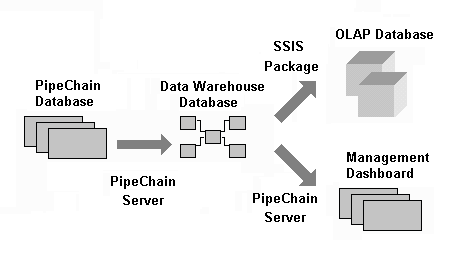Brief Overview of the Technology
PipeChain Analyzer consists of four main components: a data warehouse database, an OLAP database, a Management Dashboard Screen and programs for data transfer.

The data retrieved from the operative PipeChain database is stored in the data warehouse database in structures known as “star schemas”, which are optimized for OLAP analysis.
The data are transferred from the operative PipeChain database to the data warehouse database using the Analyzer Poll background job in the PipeChain server.
The data stored in the data warehouse database are rearranged into an OLAP database and divided into OLAP cubes. The OLAP database is created using SQL Server Analysis Services. Data transfer from the data warehouse database to the OLAP database is carried out using a SQL Server Integration Services package.
The Management Dashboard screen uses tables in the PipeChain Database which consist of a subset of the data in the Data Warehouse database.
Both the SSIS package and the update of the Management Dashboard tables are triggered by the Analyzer Poll background job.
The following list specifies the OLAP cubes currently included in PipeChain Analyzer, together with a brief description of the questions that can be answered by each cube.
-
Event – some events in PipeChain are designated as Analyzer Events, and saved to the Analyzer.
-
Supply Data Exchange – is your data exchange communication stable enough so that the information PipeChain Supply has to work with is reliable? This cube is only of interest to users with installations that use data exchanges between PipeChain Servers.
-
Supply Flow Model Precision Day – are the daily quantities of the Flow Models (demand plans or forecasts) that your customers send to you and/or you send to suppliers reliable? Flow Models are generally used for VMI flows.
-
Supply Flow Model Precision Week – are the weekly quantities of the Flow Models (demand plans or forecasts) that your customers send to you and/or you send to suppliers reliable? Flow Models are generally used for VMI flows.
-
Supply Delivery Forecast Week - As Flow Model Precision Week, however used in non-VMI flows where forecasts are represented as delivery (order line) requests.
-
Supply Inventory – are your inventory levels low enough so that you do not tie up too much capital, but high enough so that you do not have shortages?
-
Supply Shipments – how well do your actual shipments and lead time conform to what is set up in and calculated by PipeChain Supply? Do you need to change the settings or change the way shipments are made?
-
Supply Orders – As Shipments but contain data on an order level.
In order to answer these questions, a number of measures have been defined for each OLAP cube. More detailed descriptions of each OLAP cube are available in the PipeChain Analyzer User’s Reference Manual.
A data warehouse database receives data from either one PipeChain installation, or from a subset of the Business objects (there can be multiple Sites in a Business) in a PipeChain installation. However, it is not recommended to let one data warehouse receive data from multiple PipeChain Installations, since this setup will not support that KPIs are fetched "backwards" from Analyzer to the PipeChain Management Dashboard screen.


